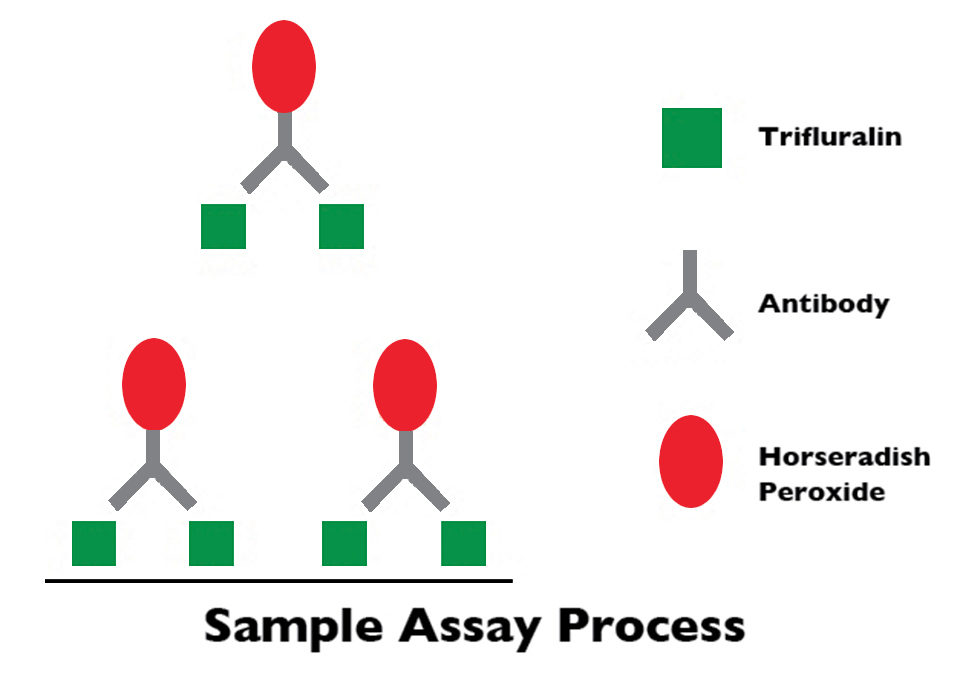Inexpensive, highly specific tests suitable for herbicide residue screening

Trifluralin is a popular pre-emergent herbicide. It is used worldwide to control weeds in a variety of crops, including soybeans, wheat, rape seed (canola), cotton, alfalfa and sunflowers. Trifluralin is also used to kill green algae in freshwater ponds and reservoirs. Trifluralin can persist in soils for many months after it is used and can leach into water, where it is highly toxic to aquatic animals.
Trifluralin belongs to a highly potent class of herbicides known as nitroanilines. Nitroanilines are highly effective in inhibiting the growth of undesirable plants by inhibiting microtubule formation. The low cost and high potency of trifluralin led to its widespread use throughout the world in the past four decades, with millions of hectares of farmland treated with trifluralin each year. However, in spite of its popularity, questions have emerged regarding the safety and environmental accumulation of trifluralin.
Trifluralin exposure
While significant toxicity is not associated with acute trifluralin exposure, chronic exposure to trifluralin in mammals can cause loss of body weight and renal failure. As outlined in the European Commission’s Trifluralin Commission report of 2007, dogs exposed to trifluralin for long periods showed weight loss, changes in blood and an increase in liver weight. The offspring of trifluralin-fed mice showed abnormalities in their skeletons. The fetuses of pregnant mice and rats fed trifluralin experienced a decrease in weight. Rats fed trifluralin developed tumors in their urinary tracts and thyroids.
These data indicate that trifluralin exposure through drinking water and other related sources may also have an adverse effect on human health. The U.S. Environmental Protection Agency (EPA) has determined that trifluralin is a possible human carcinogen. The herbicide is banned in Europe and listed as a “persistent bioaccumulative toxic” chemical by the EPA. Therefore, it is critical to monitor the levels of this widely used chemical in water, soil and food samples.
Trifluralin detection
Two methods are traditionally used to detect trifluralin in environmental samples: gas chromatography mass spectrometry (GCMS) and high-performance liquid chromatography (HPLC). While GCMS and HPLC are proven methods to detect trifluralin, they have significant limitations that reduce their utility to safeguard the environment.
The tests are expensive and time consuming, requiring extensive sample preparation procedures, sophisticated instrumentation and highly skilled analysts. GCMS and HPLC analyses can only test one sample at a time.
For reasons of cost and throughput, both GCMS and HPLC are best suited for very accurate testing of a limited number of samples. These techniques are not practical for the testing of the large number of trifluralin samples required to effectively monitor our food supply.
ELISA
Antibody-based enzyme-linked immunosorbent assay (ELISA) tests are proven, sensitive alternatives to GCMS and HPLC that can be used for the detection of herbicide residues, as well as other chemical compounds that pose potential food safety risks, such as chloramphenicol, nitrofurans and malachite green. ELISAs are high-throughput assays, with each kit allowing for the analysis of up to 96 samples simultaneously.
ELISAs are inexpensive and highly specific, which makes them suitable as herbicide residue-screening applications. Assays like the Bioo Scientific MaxSignal Trifluralin ELISA Kit also offer a streamlined sample preparation procedure that increases sample throughput.
Sample preparation
ELISA assays are performed following the directions included with the kits. For fish samples, the sample is homogenized with a suitable mixture and combined with acetonitrile and anhydrous magnesium sulfate. After centrifugation, supernatant is cleaned and dried, then resuspended. Sample is extracted and added to the plate wells in the kits.
The sample preparation protocol briefly described at the beginning of this article offers efficient recovery of trifluralin from catfish samples (Table 1). Detection limits are shown in Table 2.
Ford, Rates of trifluralin recovered from catfish, Table 1
| Spike (ppb) | Recovery (%) | Percent Bound |
|---|
Spike (ppb) | Recovery (%) | Percent Bound |
|---|---|---|
| 0 | 100 | 0.913 |
| 0.25 | 106 | 0.858 |
| 0.75 | 68 | 0.793 |
| 2.00 | 68 | 0.694 |
| 7.50 | 89 | 0.534 |
Ford, Detection limits given the dilution factor, Table 2
| Sample Type | Detection Limit (ppb) |
|---|
Sample Type | Detection Limit (ppb) |
|---|---|
| Meat | 0.4 |
| Fish | 0.4 |
(Editor’s Note: This article was originally published in the July/October 2013 print edition of the Global Aquaculture Advocate.)
Author
-
Lance Ford
Bioo Scientific
3913 Todd Lane, Suite 312
Austin, Texas 78744 USA
Tagged With
Related Posts

Intelligence
An engineer’s design for a classroom aquaculture-aquaponics system
An aquaponics teaching system was designed, built and operated by students at the University of Arizona, integrating its operation and management into the educational curriculum. This engineering design will require minimum maintenance and will last years.

Innovation & Investment
Aquaculture Exchange: George S. Lockwood
With his book, “Aquaculture: Will it Rise to Its Potential to Feed the World?” hot off the presses, the pioneer abalone farmer vents on U.S. aquaculture regulations but remains deeply optimistic about fish farming.

Responsibility
On GM foods, part 2: Let’s talk about what truly matters
With entrenched positions on GM foods, it is difficult to change the conversation, but change it we must. A perpetually contentious climate doesn’t serve us well and we must abandon the current paradigm to define a new framework that facilitates more useful discussions.

Innovation & Investment
On GM foods, part 3: Let’s decide where we’re going
To assess the role of genetic engineering in agriculture, we should first state what we want from our agricultural systems. Agriculture, and by extension the future of aquaculture, lacks a succinct direction.


